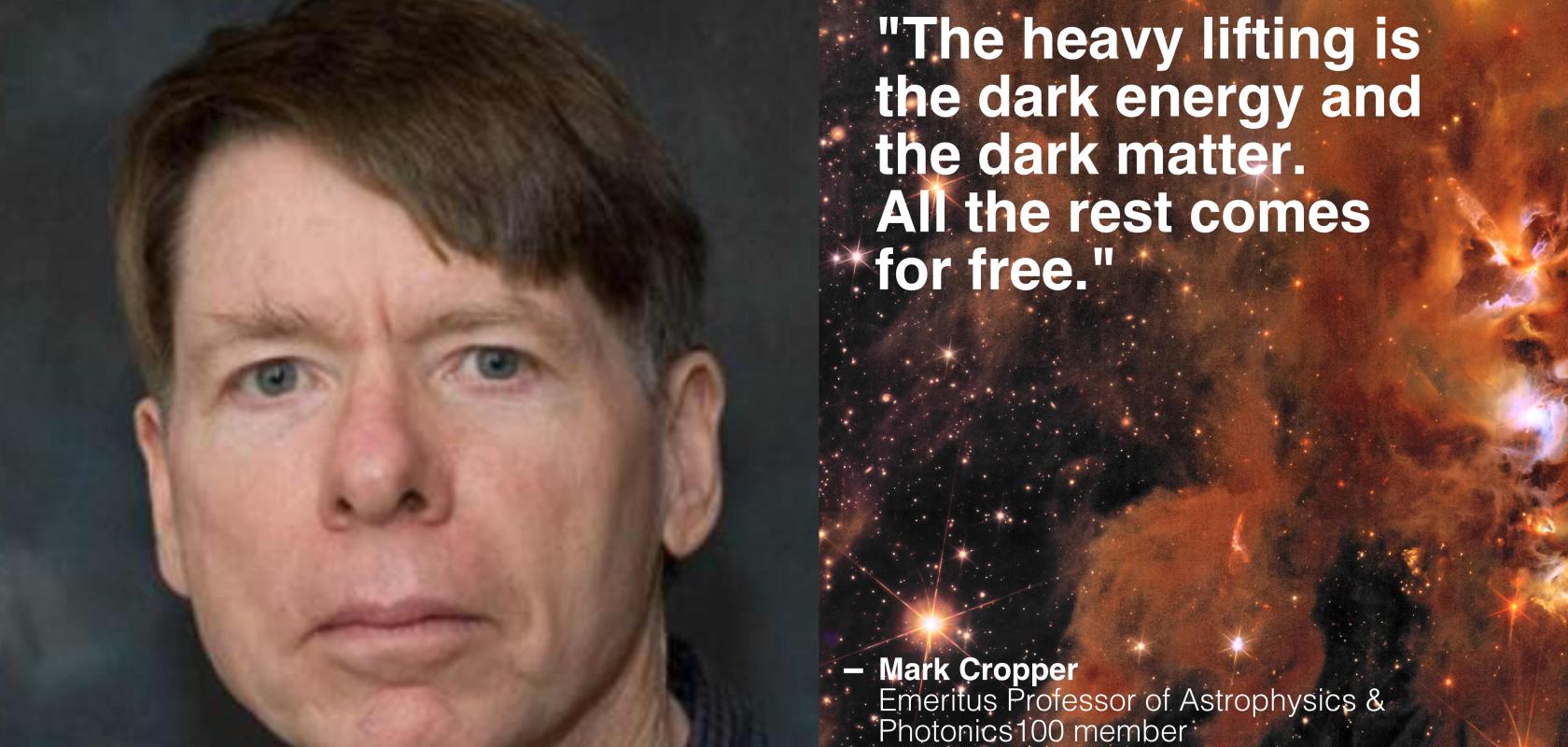In the second and final part of his discussion with Electro Optics about the ESA’s Euclid telescope, Photonics100 honouree Mark Cropper tells us about the purpose of the project, to find out more about dark energy and dark matter, and what the answers could mean for the future of science.
You mention the project’s step-by-step roadmap, were there any challenges or problems you encountered that caused you to change your approach?
That’s a very good point, because that’s the hard thing about Euclid. We have an extremely good telescope – it has to be very good over a large field of view – and we have a large camera. These large cameras have all sorts of technological, psychological and financial aspects to them, but in a sense you’re right, it’s just getting to the next level in terms of the scale. But what is particular about Euclid and was so difficult to do, is to measure enough galaxies, and to measure them brightly enough and well enough to be certain our measurements are correct.
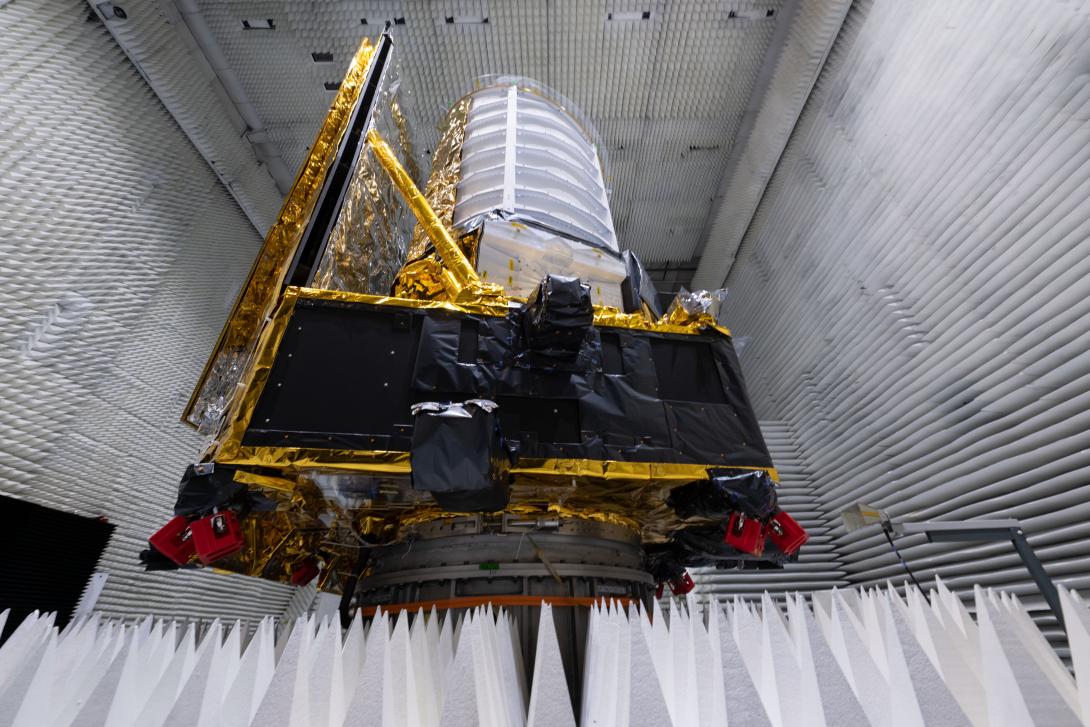
Euclid in the Compact Antenna Test Range (CATR) at Thales Alenia Space in Cannes, France. Image: ESA - M. Pédoussaut
So we have enough statistics. But are there biases in our measurements? Because it’s no good shrinking the error bar if there’s a bias. You get the wrong answer, but even with a small error, you don’t know that it’s wrong. It’s like if you do a poll and you talk only to elderly people, even if you talk to a thousand people, you’ll have a different answer to one where you talked to a lot of university students, for example. And it’s very similar for Euclid. We absolutely have to know what these biases are.
“It’s no good shrinking the error bar if there’s bias. Even with a small error, you don’t know that it’s wrong”
At the level of Euclid, which is so hard compared to anything else like Hubble, you have to know, for example, that if temperature changes in one area of the satellite, let’s say by one-tenth of a degree or one-fifth of a degree, how does that change the image? And then we have to understand how the detectors get damaged because of radiation from solar winds flying off the sun. That causes the detectors to work non-optimally and as a result that changes the shape of what you’re measuring.
The data processing is also a huge job. For example, if you want to measure a galaxy, you have to subtract the background light from the sky. The sky’s very dark in space because there’s no atmosphere, but there is still light there from dust grains in the solar system and other sources, and you have to subtract that. Then you have to make a shape measurement of each of the one and a half billion galaxies, and how you make that shape measurement is critical because you need to get down to the 1% level, and it’s very difficult to get those shape measurements accurately. In fact, you have to get down to much better than 1% in the end.
“The instrument works on what used to be two 60W lightbulbs”
So when we were building Euclid on the optical side – using gravitational lensing to measure the distortions of galaxies – we had to build a whole system that included all of these things in the satellite, in the universe, in data processing and understand how it all fits together. We had to simulate these biases to understand them because every time we made a calibration to correct a bias, what bias were we injecting into that calibration? In the last 16 years we’ve learned a lot about how to do this – it’s a scientific job in itself – to understand, but then you’ve got to build the stuff.
And you have to be practical because you can’t say to industry “I want stability to a millikelvin”, because they can’t do this stuff. So the satellite would never be selected, they’d say it was “too hard, too expensive. Sorry, we’ll choose something else.”
It’s hard in space. You can’t fix anything, so everything has to be ultra-reliable. You have a restricted number of electrical parts that you can use because of radiation damage, the detectors are very specialised and then you don’t have enough power because you can’t have a huge solar panel, and you have to make something very strong and rigid and always positioned in the same place, and yet doesn’t have very much mass. The instrument works on what used to be two 60W lightbulbs, in total. And that includes all the computing.
How hard was it, then, to develop these ultra-reliable instruments that not only work up in space but integrate with other optical and navigational equipment as well?
Maybe I should [start by saying] something about the detectors on the instruments, because the detectors are, in a sense, the core of what turns light into electrical signals. There are over 600 megapixels on this camera – to display that requires over 300 HD television sets, that’s how big it is. We had very big requirements on the detectors so we worked with E2V based in Chelmsford, UK, which is now Teledyne E2V, and they have a very interesting policy of working closely with science institutes – whether it’s physicists or medical people or ourselves in astronomy – to build specific detectors. They’re willing to customise detectors specifically for the need that you have, and this is what makes them effectively the best optical detectors.
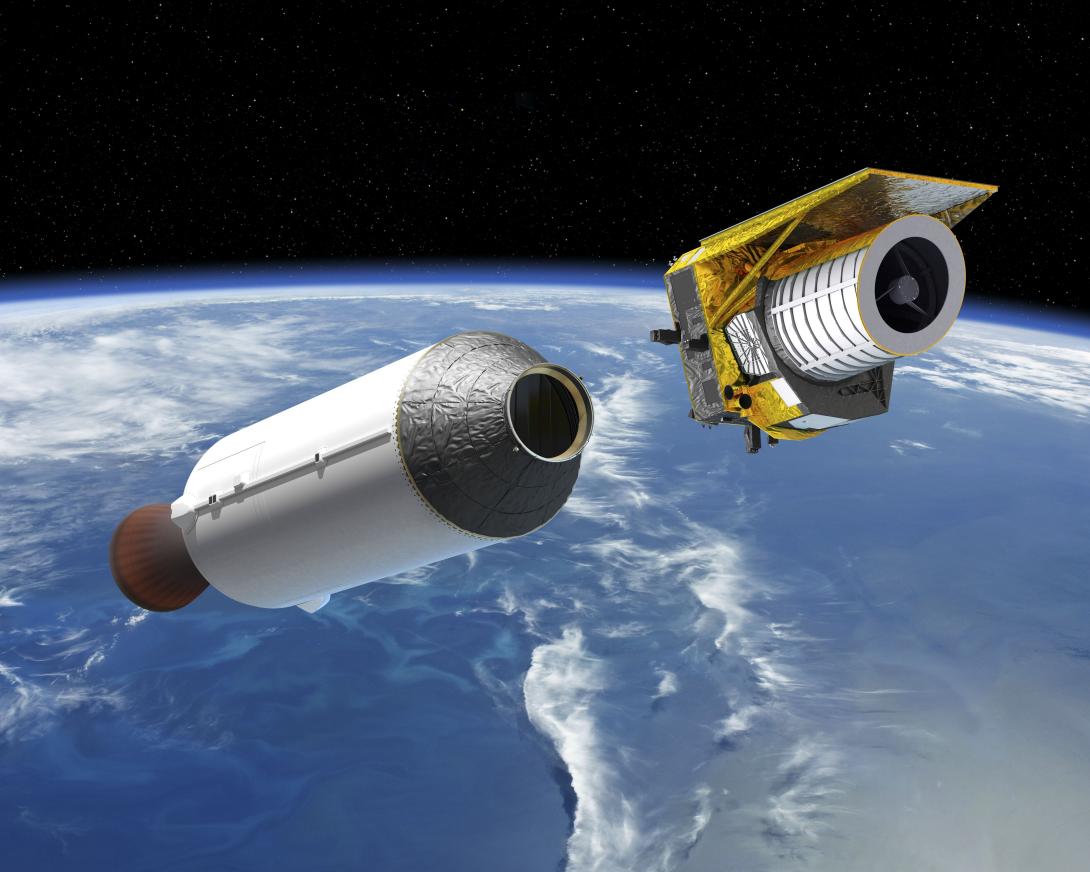
Artist's impression of the Falcon 9 launcher, carrying the 1.2-metre Euclid telescope that collects light from sources in the sky such as far-away galaxies. Image: ESA - D. Ducros
But it was a case of what did they have that we could modify and work with as a basis without pushing the costs up too much. And there’s another issue which is the technology readiness level. You don’t want to do something that’s too advanced, which then you don’t know enough about – whether it’s reliable enough. We needed something that had a history, that we knew what we’d be getting. So we worked together to come up with a detector which they especially made for Euclid, and it’s really excellent quality in every regard.
“There are over 600 megapixels on this camera – to display that requires over 300 HD television sets, that’s how big it is”
There were other technological issues within the instruments, however, like changing the little packets of charge that come out of each pixel and are handed to the next stage. That has to be amplified and then turned into a 16-bit number. So all the digital electronics had to be incredibly stable and there’s a huge amount of it. Behind these detectors they’re just packed and packed and packed with electronics, and then there’s the issue of reliability and getting the heat out.
And of course, you read out these detectors line-by-line-by-line until you finish at the bottom – it’s like how a TV used to work – and then it’s all read out simultaneously from four corners of each of the 36 detectors. So all this stuff from 144 detector chains arrives at a poor electronics box, which has to accept all this data and keep it under control, organise it, compress it and send it to the ground in real-time, and that was another challenge.
So, to move into your question [about integration], I’ve already said about how we had to make sure that all the telescopes and the specifications of the telescopes were compatible, and there was a lot of interfacing in the early days in terms of the concepts and the design. And I would say that on the electronic side, we had a standard interface that we all knew about – and this was called SpaceWire, like FireWire, but the space version of that – that we could get the data out.
“The telescope was built from silicon carbide and it’s amazing. It’s sort of half metal, half ceramic. It’s strange stuff”
The stability of the thermal interfaces was important, and we had to do that relatively cleverly. If we were bolting something onto somewhere in the satellite, how constant was the temperature? That was something we had to look into very carefully. The actual mechanical stability was also incredibly important, we couldn’t have the camera drifting compared to the telescope and so on.
The telescope was built from silicon carbide and it’s amazing. It’s sort of half metal and half ceramic, so it’s strong stuff but, of course, it’s very brittle. It’s very strong and very stiff and has very little coefficients of expansion – so you don’t have to control the temperature so carefully – because some of the instruments are at -120°C, some are at -20°C. There was a lot of engineering going on there, but once we signed up to the specifications, we were OK.
How do you expect advancing space imaging technology to contribute to future space missions?
The detectors we used have things called CCDs, which are large coupled devices and are basically the standard high-performance detectors for astronomy. There is a change coming to move to something called CMOS, and there are other infrared detectors coming. I think we may drift away from CCDs, just because CCDs have reached a stage of perfection just like the internal combustion engine. But maybe it’s just going to change to a different sort of engine. It’s difficult for me to read, but it’s something that’s under discussion.
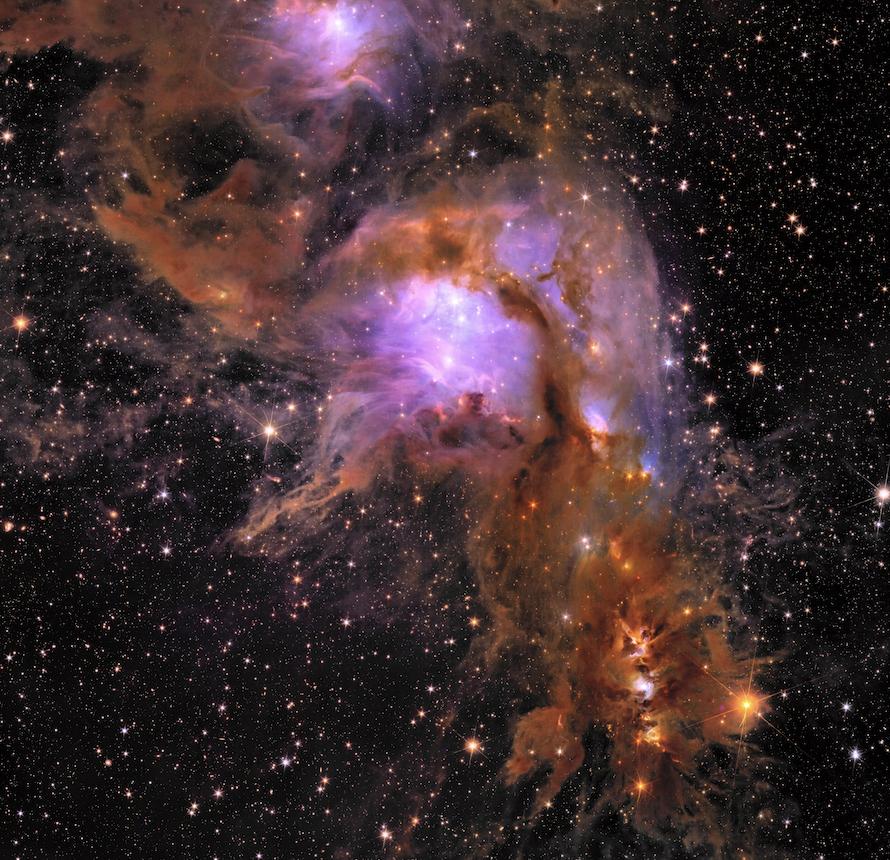
Euclid’s new image of star-forming region Messier 78. Image: ESA/Euclid/Euclid Consortium/NASA
I think it will happen for some projects that we will move to a new sort of detector technology. I think in some ways there are many psychological aspects that one needs to consider, which are often not considered. To fly this number of pixels was a huge step just to get it understood – James Webb has maybe a tenth or a fifteenth of the number of pixels that Euclid has. And the other big mission with a big focal plane is Gaia, and that has even more pixels, but there’s not enough bandwidth to send the whole image down.
“James Webb has maybe a tenth or a fifteenth of the number of pixels that Euclid has”
So I think one of the main things that made Euclid possible was being able to send the whole image down, and that was absolutely critical. They do some of the data processing on board and send down that processed data. This technology that allows us to get these huge images down was called Payband, it’s a bit like 5G instead of 4G or 3G for mobile phones. I have a reasonably fast internet connection [at home], about 30MB per second, but if I try to download a raw image from Euclid it takes me 20 minutes. So everything is slow, when you want to rotate or do anything with the image, it takes a huge amount of time, even with whole farms of computers.
And I think there’s a psychological aspect of it being possible to fly this number of detectors, process this amount of information and to get it down. It makes it provable that we can do it, and makes it acceptable in terms of being a project. It’s a software project, and you know how hard it is to get software projects done, but in science, it gets done.
How far can the use of VIS cameras take us in terms of space exploration? And what is the next step?
There are two methods in science, the inductive method and the deductive method. In one, you can look at the data and say “I can put a straight line through this. I can see this is what is happening and then work out something directly from the data.” The other method is you say “OK, I’ve got the data set. I’m going to compare it to various theoretical models I have of the universe, and then I’m going to see which one is best. Then I’ll throw out whole classes of possibilities – for dark energy there are hundreds of possible models.” And so for example at CERN, they work entirely in that latter way.
“It becomes a seething soup of virtual particles”
So we have all these ideas and we will test these models using various energy fields in the universe or something about the nothingness of space, so this is about the energy in a vacuum. You know, if you took all the atoms out of a cube in space, because of Heisenberg’s uncertainty principle of quantum mechanics you’d have electrons and positrons and quarks and things appearing and disappearing in a short time, so it becomes a seething soup of virtual particles. The energy of nothingness is not zero, but it’s not clear what it is. And there’s a huge gap between what the physicists’ calculations give and what we are measuring.
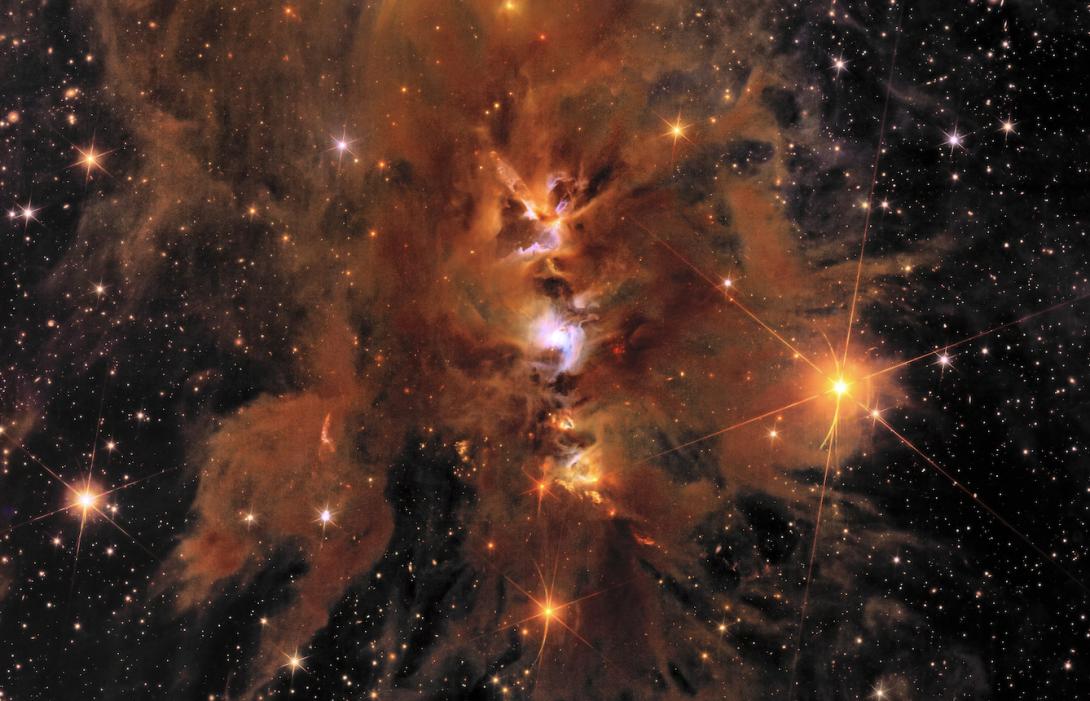
A close-up view of stellar nursery 78, from Euclid. Image: ESA/Euclid/Euclid Consortium/NASA
So we’ll do a careful statistical analysis using these models that we have, and that will lead us in the right direction. We won’t have to test 200 models, whole classes of models will disappear and we’ll be directed towards what is dark energy. But there’s a huge amount of other science that will come out of Euclid. The vast majority of papers that come out of Euclid will be more normal astronomy, if you like, about galaxies and how they evolve and so on. And even about distant parts of our solar system. There are lots and lots of different aspects.
“The energy of nothingness is not zero, but it’s not clear what it is”
Euclid will also be tremendously important for follow-up studies. So, for example, you only have to look at one image from Euclid and it has so many different things in because it’s so huge. There are all sorts of objects out there that we don’t know very much about, there are lots of rare objects that you only get if you observe a lot of the sky, and there are also very faint or diffuse objects, and these are things that can be followed up with James Webb or Hubble. Hubble only does a little postage stamp, but it has to know what to look at. So [Euclid is] a finder for more detailed observations, but the heavy lifting is the dark energy and the dark matter, and all the rest comes for free.
Find the first part of this interview with Mark Cropper on the Euclid telescope here:

